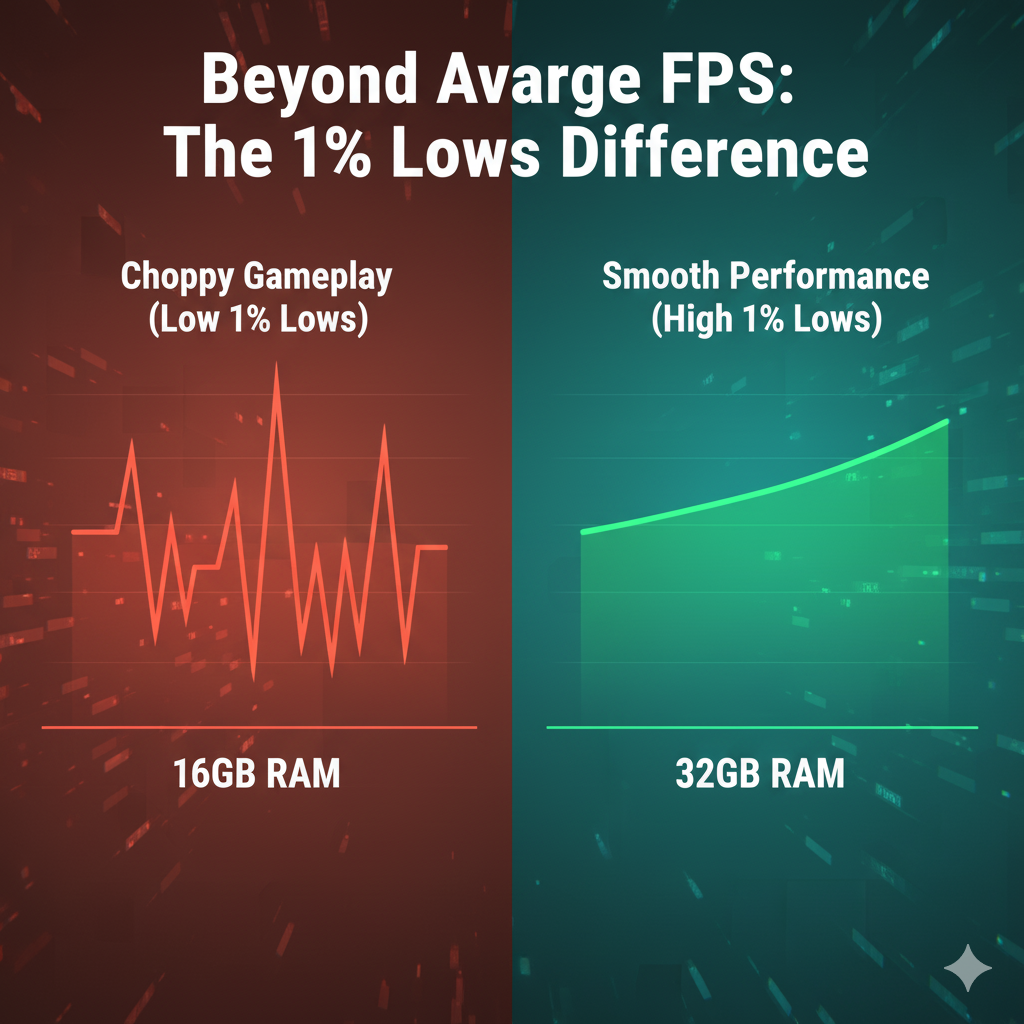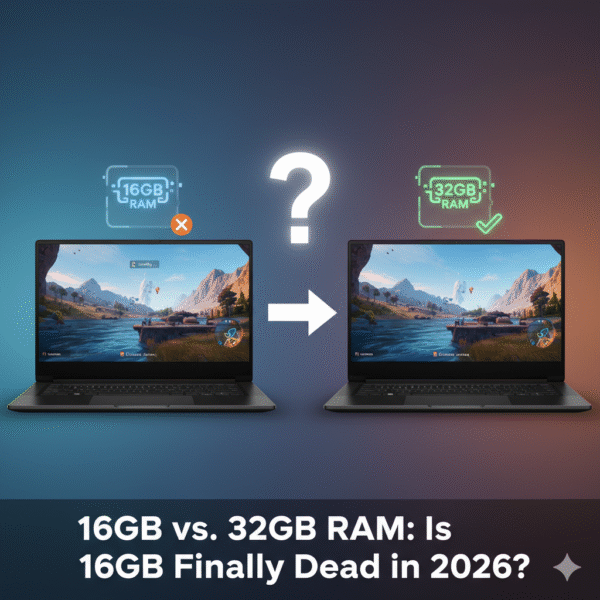For years, the advice was simple: 16GB of RAM is the perfect sweet spot for gaming. It was the common wisdom, the comfortable middle ground. But here in 2026, the game has changed—literally. Modern video games and how we use our laptops have pushed 16GB from the recommended standard to the new bare minimum.
If you’re wondering, “Is 32GB RAM overkill for a gaming laptop in 2026?“—you’re asking the right question. The honest answer is that for a massive segment of users, it’s not overkill; it’s a necessity for a smooth, future-proof experience.
Before we dive in, here’s how 16GB begins to show its limits, and when upgrading to 32GB of DDR5 truly elevates your laptop to powerhouse status.
1. The Core Performance Secret: Not Average FPS, But 1% Lows
When most people see benchmark videos, they focus on the big, easy-to-understand number: the average Frames Per Second (FPS). They see 16GB giving 100 FPS and 32GB giving 102 FPS and think, “The upgrade isn’t worth it.”
This misses the single most important metric for a fluid user experience: the 1% Low FPS.
What are 1% Lows?
Imagine driving your gaming laptop like a race car.
- Average FPS is your top speed on the straightaways.
- 1% Low FPS is the lowest speed you hit when taking a sharp turn or navigating traffic.
A low 1% FPS means the game is briefly freezing, skipping, or stuttering. This is what ruins competitive clutch moments and breaks immersion in beautiful cutscenes. It’s the difference between a smooth video and a choppy one.

The RAM-Stutter Connection
When your 16GB of RAM runs out of space, the operating system (Windows) performs an emergency procedure called paging—it moves data it thinks you won’t need immediately from the super-fast RAM to your much slower SSD (the page file).
This sudden, forced swap causes massive frame-time spikes, sending your 1% Lows FPS plummeting. The result? A jarring, noticeable stutter.
Upgrading to 32GB provides the massive buffer needed to absorb these data spikes, completely sidestepping the paging crisis and delivering a closer, more consistent gap between your average FPS and your 1% Lows. This, more than anything, is the invisible performance boost of 32GB.
2. The New Generation of Memory-Hungry Games
The demands of new video game engines are the primary driver pushing 16GB into retirement.
The Unreal Engine 5 Problem
Modern blockbusters built on next-gen tech like Unreal Engine 5 (UE5) are simply too aggressive for 16GB to handle gracefully. Features like Nanite (which handles billions of polygons) and Lumen (global real-time lighting) require vast amounts of texture and geometry data to be ready in RAM at a moment’s notice.
The phrase RAM requirement for Unreal Engine 5 games 32GB isn’t marketing; it’s engineering reality. To truly enjoy these titles at high resolution and detail settings, 32GB of RAM is what keeps the engine from struggling.
The Open-World and Modding Tax
If you play games with limitless scope, 32GB is an absolute must:
- Seamless Open World: Modern games stream massive worlds dynamically, utilizing RAM efficiently. This is where the 32GB vs 16GB performance difference shines—fewer texture delays and smoother transitions.
- The Modding Community: For community-driven sandbox and strategy games (Cities: Skylines, Starfield, Escape from Tarkov), the memory demand is entirely user-dependent. If you love piling on high-resolution texture packs, new models, and deep gameplay mechanics, the question of how much RAM is needed for heavily modded games in 2026 has a clear answer: 32GB. The more mods, the more memory you need to load everything up front.
3. The Unavoidable Multitasking Reality
Very few people use a gaming laptop solely to play one game. Our machines are the ultimate digital hubs, and 32GB is the price of admission for freedom.
The Streamer’s Mandate
If you stream your gameplay, 16GB is a bottleneck from the moment you hit “Go Live.” Your RAM needs to simultaneously handle:
- The Game (8GB – 15GB)
- OBS/Streaming Software (2GB – 4GB)
- Discord/Voice Chat/Browser Tabs (3GB – 5GB+)
This total usage easily breaks the 16GB barrier, making 32GB RAM beneficial for streaming and gaming simultaneously, the difference between a high-quality stream and a stuttering, unprofessional mess.
The Developer, Engineer, and Creator Crossover
Many people with high-end gaming laptops also use them for work. If your work involves:
- Virtual Machines (VMs): Running a separate operating system on top of Windows (use: gaming laptop RAM for Docker and virtual machines). VMs reserve large chunks of RAM exclusively.
- Video Editing/3D Rendering: Editing 4K video footage or using heavy creative suite applications requires staggering amounts of RAM to handle project files and previews.
In these dual-purpose scenarios, 32GB is the professional minimum.
4. The Final Verdict: Future-Proofing and the Cost-Benefit
The simple decision often comes down to money, especially when asking: Is 32GB RAM overkill for a gaming laptop in 2026?
There is a Hidden Tax of Shared Memory.
It should be kept in mind that the vast majority of gaming laptops include an Integrated GPU (iGPU) on the processor as well. Although you may have a powerful dedicated graphics card (such as an RTX 50-series), even in the beginning, the iGPU usually claims 1GB to 2GB of system RAM.
You may have 16GB, but you may actually get 14GB or 15GB of that memory to use, focusing on games and applications. It has 32GB, and the loss of 2GB is not noticeable at all.
DDR5, Upgradeability, and Cost
Contemporary gaming laptops have a dual-channel (2x16GB) memory based on DDR5-5600. The capacity difference is immense, but the difference in performance of a 2x8GB kit and the 2x16GB kit is less than never before.
- The Financial Reality: When purchasing a new laptop, the difference between 16GB and 32GB is not always very high in terms of price in comparison with the overall cost of the device.
- The Upgrade Difficulty: The RAM (SO-DIMM) on laptops is infamously not upgradeable afterward, and in most models with a thin and lightweight design, it is soldered to the motherboard and can not be upgraded after.
The 32GB upfront is not in the luxury category but rather an insurance policy. It also ensures that the high speed CPU and graphics that you have recently purchased are not bottlenecked and your laptop will not be slow in a few years only two or three.
If you are a serious gamer, a creative pro, or just someone who wants to run their system without compromise, 32GB is the smart, future-proof choice for your next gaming laptop.



